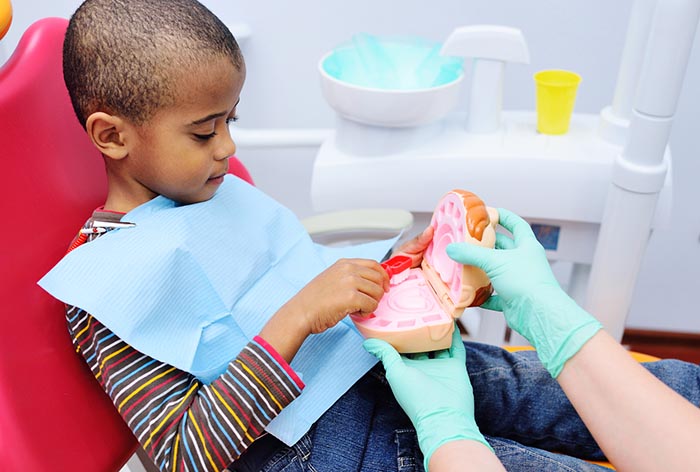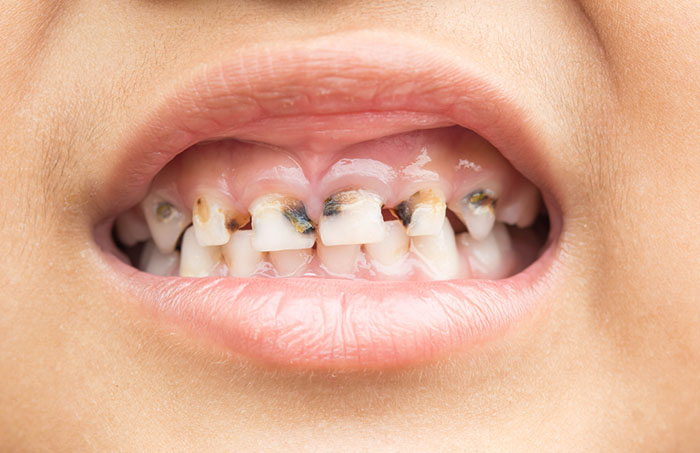
Tooth decay is one of the most common dental problems in children. If left untreated, tooth decay and cavities can eventually reach the affected tooth’s inner pulp, resulting in the need for more extensive treatments. Detecting tooth decay and cavity symptoms early on makes treatment more manageable, less invasive, and may help reduce a child’s overall anxiety when visiting the dentist.
The pediatric dentists at Absolute Dental share what you need to know about tooth decay in kids.
Is it time to get your child to the dentist? Contact Absolute Dental today to make an appointment with our pediatric dental team.
What Is Tooth Decay?
According to dental healthcare professions1, tooth decay in children occurs when the enamel of a tooth breaks down or is damaged. Enamel is the hard surface that covers the tooth. Unfortunately, the destruction of tooth enamel is irreversible and leaves the tooth vulnerable to cavities and other dental issues.
What Causes Tooth Decay in Kids?
Many factors can put your child at an increased risk of developing cavities. This often includes:
Poor Oral Hygiene
Improper brushing technique is the most obvious offender. Many children do not know how to brush their teeth properly. Also, they might not have the coordination or precision necessary to reach every single tooth.
It’s recommended that parents monitor and help children brush their teeth until they’re about six years old by brushing twice a day with fluoride toothpaste.
Diets High in Sugar
Another risk factor for children involves their diet. Kids love sugar, and it’s not uncommon for them to want candy, ice cream, and other sugary food and drinks. The bacteria inside your child’s mouth feed off these sugars, producing a sticky substance known as plaque. The accumulation of plaque and bacteria in your mouth contributes to tooth decay2 and poor oral health.
Limited or No Fluoride
According to numbers published by the Centers for Disease Control and Prevention (CDC)3, children who live in areas with fluoridated tap water have far fewer cavities than those whose water supply does not have fluoride. Also, kids who brush with fluoride toothpaste lower their risk of developing tooth decay and cavities.
Get your kid’s oral health back on track! Contact our pediatric dental team to schedule an appointment today.
What Are Common Tooth Decay Symptoms in Children?
Small children and toddlers often do not know how to convey pain and discomfort. Also, the decay usually won’t cause pain until it reaches the inner pulp of the tooth and the damage is more severe. This is why early detection of cavities is so vital to your child’s dental health.
Some common symptoms to look for include:
- White spots on the teeth
- Dark spots on the teeth
- Pits or holes in the teeth
- Fussiness or mood swings
- Lethargy
- Avoidance of eating
- Tooth sensitivity when drinking hot or cold liquids
- Holding the face or jaw
- Tooth pain
- Swelling around the mouth area
As a parent, you can often tell when something isn’t right. If you notice that your child is acting differently and you suspect a toothache, schedule a check-up with your pediatric dentist as soon as possible. Catching the cavity early can help prevent the decay from getting worse and requiring more invasive treatments.
What Are Tooth Decay Treatment Options for Pediatric Cavities?
If your dentist informs you of decay in your child’s tooth, several treatment options may be considered, including:
1.Dental Fillings
The most common tooth decay treatment for a child who has one or more cavities involves dental fillings. Dental fillings are made from composite resin, which provides a tooth-colored restoration for your child’s smile. First, decay is removed from the tooth. Then, the hole left by the cavity is filled. This stops the decay and prevents it from getting worse.
2.Pulpotomy
A pulpotomy may be needed for decay that has reached the tooth’s inner pulp. A pulpotomy is similar to a root canal and typically only used on children. Pulpotomies involve removing only a tiny portion of the inner pulp and placing a medicated packing material inside the tooth before closing it with a tooth-colored filling.
3.Tooth Extraction
For severe tooth decay, some dentists will recommend completely extracting the tooth. Extraction is typically only recommended if decay is serious enough that no other treatment option is available to save the tooth. Early extraction of baby teeth can lead to problems with chewing, eating, and orthodontic issues later on.
4.Preventative Treatments
Preventative treatment options include fluoride varnishes and sealants, which can easily be done in the dental office. Sealants are used to protect the chewing surfaces of the back teeth by creating a transparent layer of BPA-free plastic over the grooves and fissures that can be difficult to clean. Fluoride varnishes can be applied to strengthen teeth and prevent tooth decay.
Keep your kid’s teeth healthy and cavity-free. Make an appointment with our pediatric dentists at Absolute Dental today.
How Can I Prevent Tooth Decay in My Kid’s Teeth?
The best thing you can do for your child’s dental health is to help them prevent cavities. Talk to your child about the importance of proper oral hygiene and dental care, including how they should be brushing their teeth and flossing.
- Start a dental routine – Until your child is about six years old, it’s best if parents monitor children while brushing to ensure plaque and oral bacteria get cleared away. Starting young with good hygiene will give them a better chance of preventing tooth decay and gum diseases as they grow.
- Regular visits to the dentist – Check-ups are critical for identifying decay and providing quick, efficient treatment when needed. You’ll also have a chance to catch rare dental issues early, such as mesiodens, before they cause more significant problems. You should aim to bring your child into the office every six months for professional cleaning, fluoride treatment application, and an X-ray.
It’s never too early to get your child in for their first dental visit. Many dental professionals recommend that infants come in for their first appointment as soon as their first tooth appears. Not only is the dentist able to monitor the growth and development of your child’s smile, but they’ll give you tips on how to practice the best oral hygiene with your child at home.
Children’s Dentist Near Me
While cavities are common among children, they can be prevented with better oral hygiene techniques and preventative measures at the dental office. If you suspect that your child has cavities, it’s always good to get them checked by scheduling a pediatric dentistry appointment and getting prompt treatment.
Is there a children’s dentist near me? Located across Nevada, the pediatric dentists at Absolute Dental can help your children adopt healthy habits and keep their teeth strong and healthy to maintain a full and bright smile.
Sources:
1Kapner, M., Wojcik, S. Tooth Decay in Children. University of Rochester Medical Center. Retrieved 19 April 2022.
2Johns Hopkins Medicine. Tooth Decay (Caries or Cavities) in Children. Retrieved 19 April 2022.
3Centers for Disease Control and Prevention (CDC). (6 April 2022). Children’s Oral Health Retrieved 19 April 2022.



